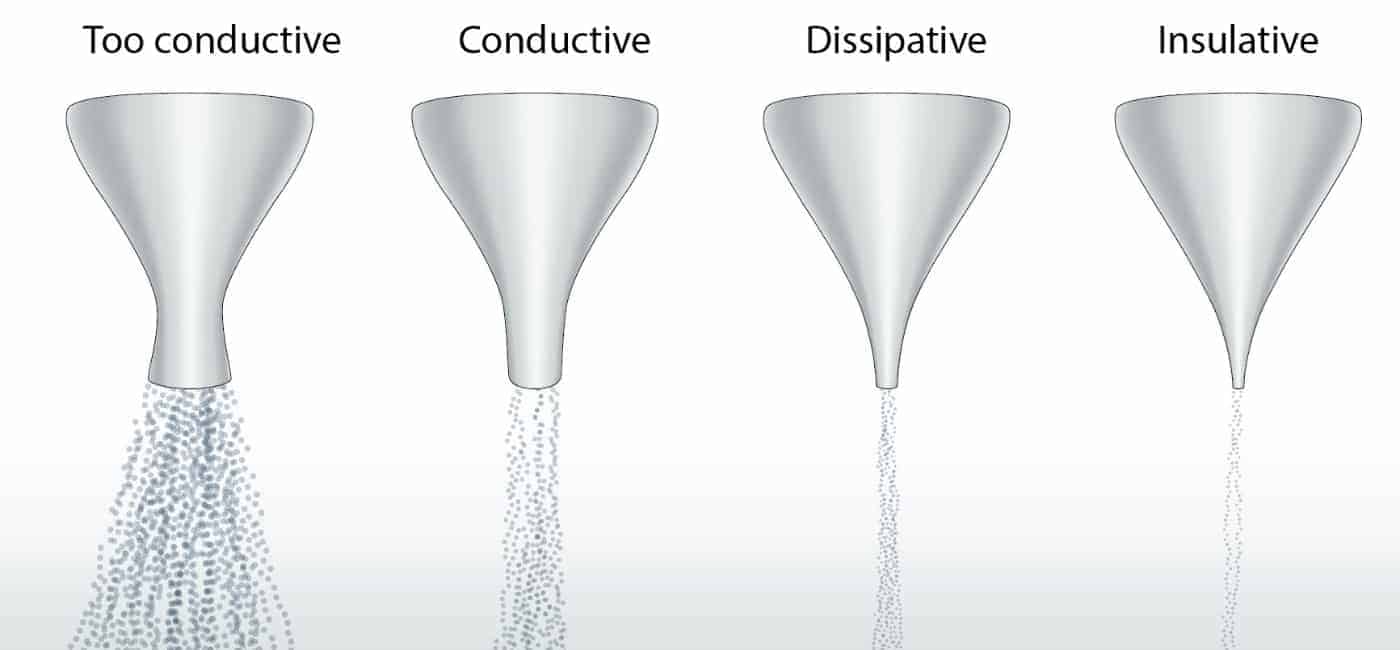
Conductive versus Dissipative Flooring: Does it Matter?
[18 min read, 5 min videos]
Post Summary
Contrary to popular belief, conductive and dissipative are not qualitative descriptors.
This article explains why the terms “conductive” and “static dissipative” can be misleading. Why the right floor for an electronics application can fail in an end user space. And why—to choose the right floor for the application—it’s best to eliminate conductive and dissipative from conversations on specifying or selecting ESD floors.
Need additional information about StaticWorx products? Learn more about our ESD flooring products.
Which is better—conductive or dissipative? View the highlights of the argument.
A combination of industry-specific standards, misinformation, and spotty technical knowledge has created a meaningless—and, in certain cases involving energized equipment, potentially harmful—controversy over the comparative advantages and pitfalls of conductive vs. static-dissipative flooring materials.
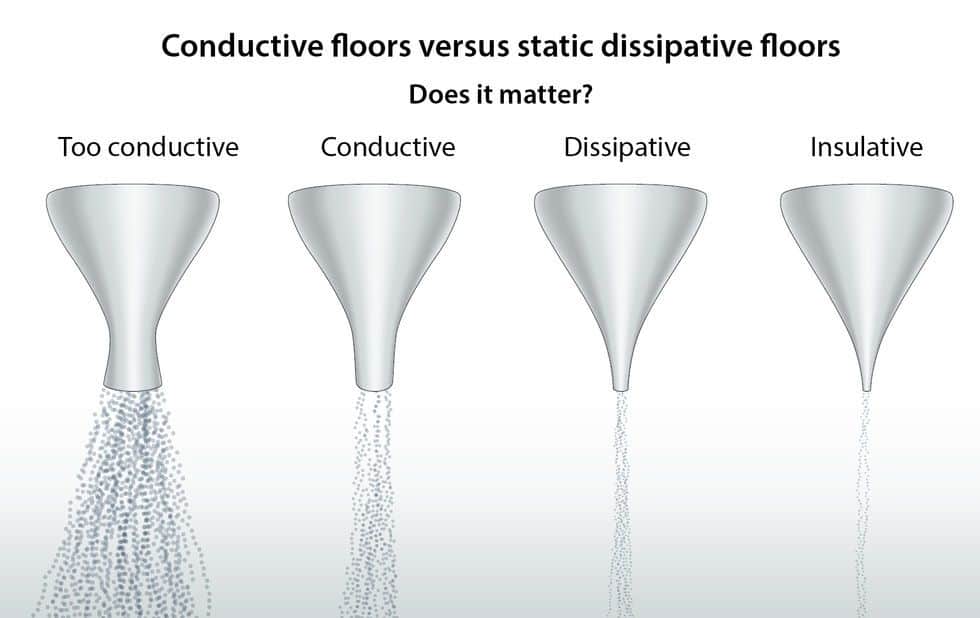

Unfamiliar with technical details, specifiers often require a floor to be conductive or dissipative, convinced one is inherently better than the other. This is simply not true. In fact, selecting a floor based solely on whether it’s conductive or static dissipative could lead to performance failures and unwanted ESD events.
Conductive and static dissipative are not qualitative descriptors.
Conductive and dissipative are resistance categories used by standards-setting organizations to describe the speed at which currents flow across or through a flooring material. Which would be more appropriate depends upon the application, flooring material, and the shoes people wear in the environment.
What Is Electrostatic Discharge (ESD)?
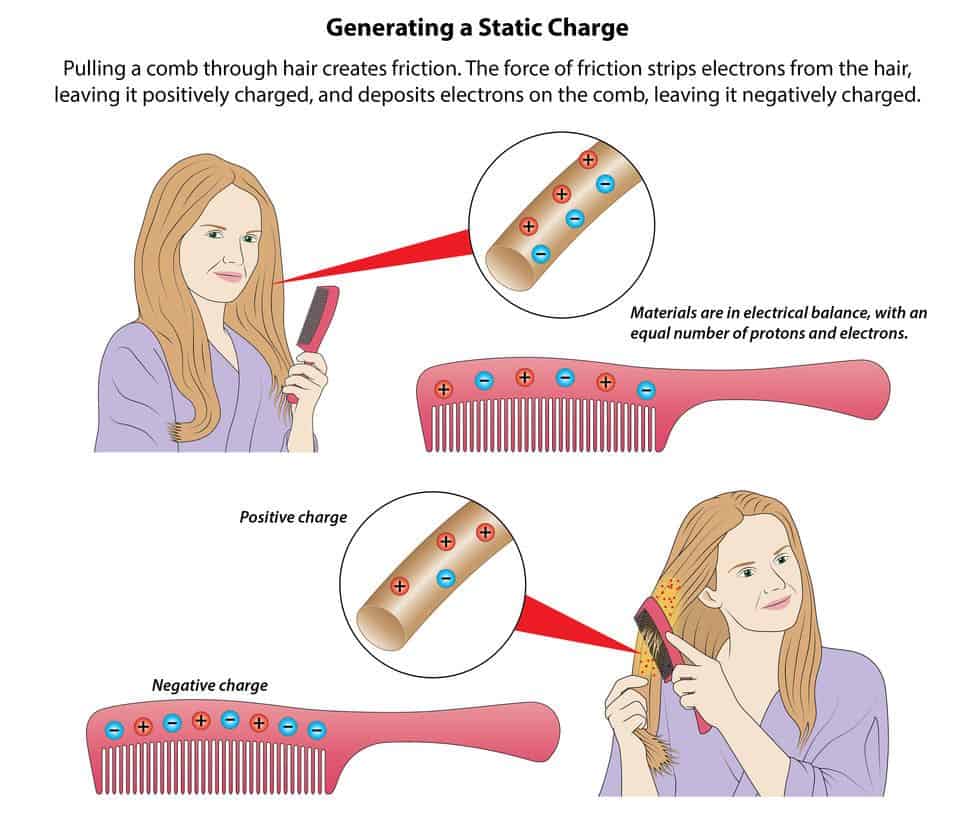
Static electricity results from the frictional contact between two chemically dissimilar materials. Dragging a comb through your hair, rubbing a balloon against a nylon shirt, and walking across a floor all generate static charges. The voltage remains on the surface of your body—static—until you touch another person or an object with some electrical conductivity (a metal doorknob, for example), then the charge jumps to that person or object.

To notice the effects of static electricity, the discharge must be at least 3500 volts—the threshold for human perception. But a discharge as tiny as 500 volts—or, in the case of highly sensitive microcircuits, 100, or even 20 volts—can jumble data and damage or destroy the ultra-sensitive, high-speed microcircuits inside high performance electronic components.
Static electricity results from the frictional contact between two chemically dissimilar materials. Dragging a comb through your hair, rubbing a balloon against a nylon shirt, and walking across a floor all generate static charges. The voltage remains on the surface of your body—static—until you touch another person or an object with some electrical conductivity (a metal doorknob, for example), then the charge jumps to that person or object.
Like all electrical current, static electricity seeks its easiest path to ground. We call this the “path of least resistance.” The person or object you touch provides a potential pathway to ground. This sudden transfer of electrical current (or static electricity) is called an electrostatic discharge, or ESD.
To notice the effects of static electricity, the discharge must be at least 3500 volts—the threshold for human perception. But a discharge as tiny as 500 volts—or, in the case of highly sensitive microcircuits, 100, or even 20 volts—can jumble data and damage or destroy the ultra-sensitive, high-speed microcircuits inside high performance electronic components.
Static in the Workplace
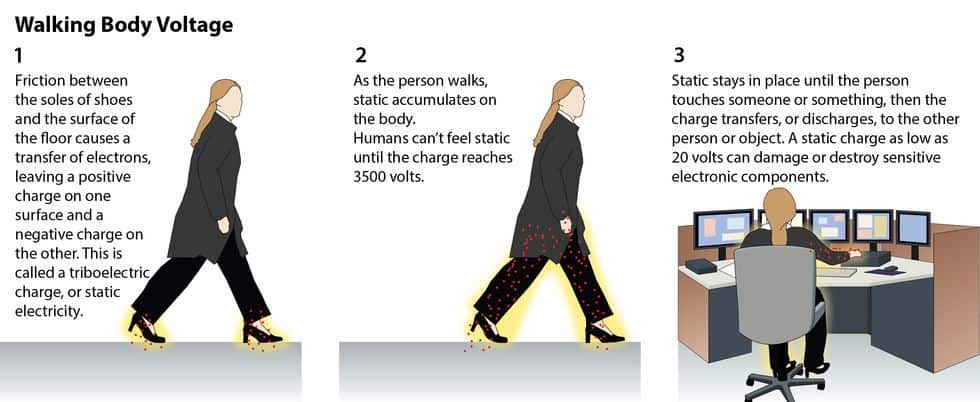

That’s why the primary means—or first line of defense—in preventing damaging ESD events is to install an ESD floor.
To perform properly, an ESD floor must meet two criteria:
- it must draw static electricity away from people or charged objects and conduct those charges safely and effectively to ground;
- it must prevent static generation in the first place.
The floor’s conductive or dissipative properties are responsible for the first criterion: grounding static charges.
Conductivity and Electrical Resistance
To predict how efficiently (how quickly or slowly) an ESD floor will ground static charges, we measure the electrical resistance of the flooring material using an ohm meter.
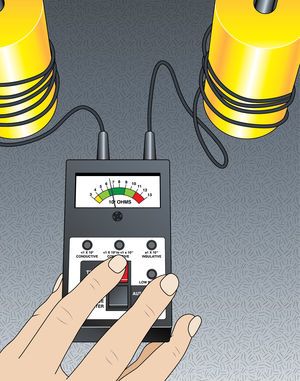
Resistance standards in every industry follow the procedures outlined in ESD Standard Test Method 7.1. Using an instrument called an ohm meter, we measure the electrical resistance of the flooring material in ohms (Ω).
- Flooring materials measuring less than or equal to 1.0 x 10E6 are considered conductive.
- Flooring materials measuring greater than 1.0 x 10E6 and less than or equal to 1.0 x 10E9 are considered static-dissipative.
To predict how efficiently (how quickly or slowly) an ESD floor will ground static charges, we measure the electrical resistance of the flooring material using an ohm meter.
Resistance is the opposite of conductivity—the capacity of a material to slow, or resist, the flow of electricity. If resistance is low—the floor is more conductive—charges will flow quickly. If resistance is high—the floor is dissipative (or less conductive)—charges will have a harder time moving and flow more slowly.
Resistance standards in every industry follow the procedures outlined in ESD Standard Test Method 7.1. Using an instrument called an ohm meter, we measure the electrical resistance of the flooring material in ohms (Ω).
- Flooring materials measuring less than or equal to 1.0 x 10E6 are considered conductive.
- Flooring materials measuring greater than 1.0 x 10E6 and less than or equal to 1.0 x 10E9 are considered static-dissipative.
✓ visual selector guide;
✓ walking body voltage/low static generation;
✓ resistance requirements and testing;
✓ ESD flooring comparison;
✓ industry standards & test methods;
✓ key ESD terms
Resistance Standards: Requirements Are Industry-Specific
Part of the confusion over whether a floor “should be” conductive or static dissipative stems from differences in electrical requirements for different industries. Resistance standards are industry-specific, and also depend upon the type of shoes people wear in the environment.
For electronics manufacturing and handling applications, ESD Association* standard ANSI/ESD S20.20 requires ESD flooring materials to measure ≤ 1.0 x 10E9 Ω (1 billion ohms)—which encompasses both conductive and static-dissipative flooring options. The ESD Association does not preference one range over the other.
- The ESD Association is a professional organization focused on avoiding electrostatic discharge (ESD).
Standards for the telecommunications industry*—e.g., critical call centers, 9-1-1 dispatch operations, and government offices—and the government standard* for flight-control towers and operations using their equipment, require floors to measure ≤ 1.0 x 10E9 (at the high end) and ≥ 1.0 x 10E6 (at the low end).**
* Motorola R56, ATIS 0600321 and FAA 019f
** For an in-depth discussion on resistance standards for mission-critical applications, see our article “Electrical Resistance in Mission-Critical Spaces.”
Upper limits
With few exceptions*, all standards organizations set an upper limit on resistance values of 1.0 x 10E9. Above 10E9, static builds faster than the floor can discharge harmful currents to ground.
The conductivity of all ESD floors is affected by changes in relative humidity (RH) and other environmental factors. We know water is a conductor; so moisture adds to the conductivity of a material. Low RH—very dry air—can do the opposite, raising the resistance of a flooring material by an order of magnitude, if not more. This means, the resistance of a floor measuring 10E9 could go as high as 10E10. Above 10E10, the floor in effect becomes an insulator, offering no static protection at all.
This is why almost all standards set a 10E9 ceiling on resistance.
- IBM recommendations for server rooms sets an upper limit of 10E10. For reasons noted above, StaticWorx strongly suggests specifying a resistance no higher than 10E9 and, optimally, setting a resistance ceiling of 10E8.
Variations in Lower Limits
If resistance is too low—or if the floor is more conductive than the conductive adhesive or underlayment—charges could shoot across the surface of the floor*, rather than flowing downward to ground. If a person sitting, standing or kneeling on an overly conductive floor—working on an open server, for instance—were to come into contact with a live current, the current would shoot from the contacting body part (the hand, for instance), through the body, out through the feet and across the floor, exposing him or her to a potentially harmful electric shock+.
- This information applies specifically to ESD carpet, as indicated in tests performed by an independent lab.
- Paraphrased from “How Electrical Current Affects the Human Body,” published by OSHA (Occupational Safety and Health Administration) on the organization’s web site.
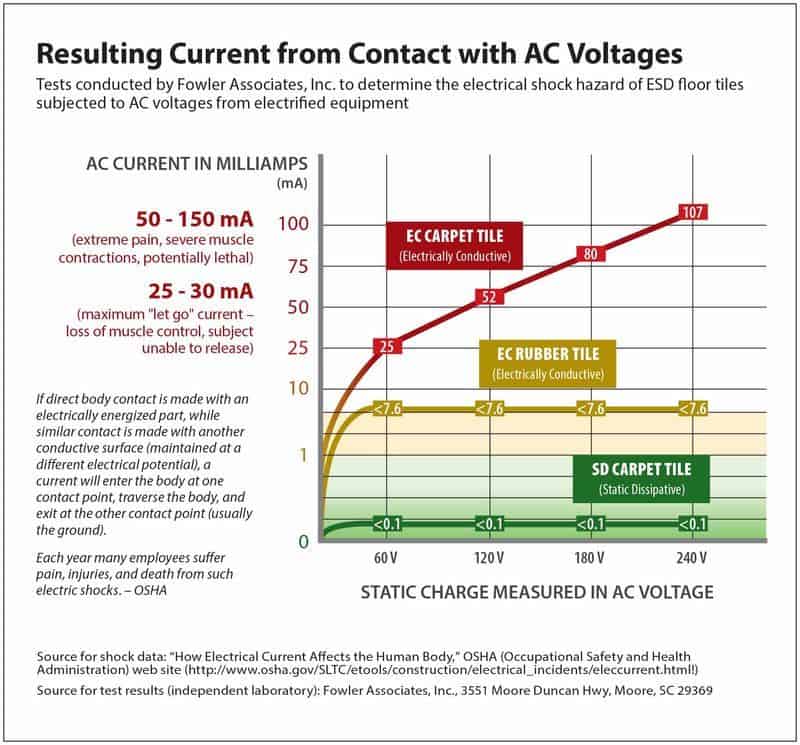
In electronics manufacturing and handling facilities—as required by ANSI/ESD S20.20—every person in the ESD-protected area (EPA) is required to use some form of static-protective footwear (toe, heel or sole straps or ESD shoes); these mandates are strictly enforced.
The built-in resistors in ESD footwear provide some protection from electric shocks. That’s why, in electronics manufacturing and handling facilities, there’s no need for a lower limit on resistance values.
In telecom spaces, dispatch centers, networked government offices, flight towers and other end-user spaces, there are no mandates or controls involving footwear. People wear regular footwear, or street shoes, that do not protect against electrical shocks. For safety reasons, to protect personnel working near energized equipment, the resistance of flooring materials used in these end-user environments must be no lower than 10E6.*
- As outlined in industry standards (Motorola R56, ATIS 0600321 and FAA 019f).
Conductive or Dissipative: Which is Better and Why?
At one time, some ESD flooring providers believed—incorrectly—that the performance of a conductive floor was superior to flooring materials with less conductivity. Or vice versa. As outlined above, these claims are not true and lab tests easily debunk these beliefs. Speaking purely to the capacity for a floor to discharge static safety to ground, both conductive and dissipative floors will do the job adequately.
When evaluating the electrical performance of an ESD floor, rather than focusing on its resistive properties, which tell only part of the story, specifiers/buyers should consider:
- Industry standards
- Footwear
- Flooring material
- Proper testing (per industry test methods)
Standards
As outlined above, resistance standards vary by industry. Specifying a floor for an end-user environment based on values outlined in a standard designed for electronics manufacturing in controlled factories with limited access is not only foolhardy, it could be downright dangerous.
By the same token, insisting that a floor for an electronics facility meet the dissipative values required by telecom and FAA standards eliminates perfectly good (depending upon the application perhaps even optimal) choices—such as conductive vinyl, ESD epoxy, and conductive rubber—from consideration.
Footwear
As a safety consideration for end-user environments housing electrified equipment, footwear should be factored into the equation. Because a built-in resistor limits exposure to electrical current, static-control footwear provides protection against electrical shock that regular footwear simply doesn’t offer. If static-control footwear can’t be used or its usage can’t be enforced, the floor needs to compensate for this condition.

Footwear also affects the electrical performance of some ESD flooring materials. Vinyl, for instance—whether conductive or dissipative—can be a static-generating material. When people in regular (street) shoes walk on a conductive vinyl floor, the contact between the floor and soles of their shoes can generate significant static charges.
In conjunction with ESD footwear, vinyl performs well. That’s because the conductive elements in static-protective footwear form an electrical bond with the embedded carbon in ESD vinyl, preventing static charges from building on the person or soles of his or her shoes.
While conductive or dissipative vinyl floor can perform well, in electronics applications with footwear mandates, it cannot address the static-control challenges of an end-user environment. Without static-protective footwear, ESD vinyl performs no better than a regular (not-ESD) static-generating floor.
Flooring material
The performance of ESD flooring materials varies from product to product, due to differences in their manufacturing processes.
Unlike conductive vinyl, static-dissipative (SDT) vinyl composition tile has no exposed conductive filaments. SDT vinyl gains most of its conductivity from a field-applied topical wax that wears off over time. Vigilant reapplicant of ESD wax could alleviate the problem; but without protocols to monitor resistance, ensure the wax is applied at proper intervals, and control maintenance procedures, the failure rate could be high.
In conductive vinyl, closely packed carbon filaments or veins enable reliable contact with the conductive elements in ESD footwear. As its electrical properties are inherent, conductive vinyl does not require a special wax to enhance performance, and offers permanent static-protection, making it the better ESD vinyl option.
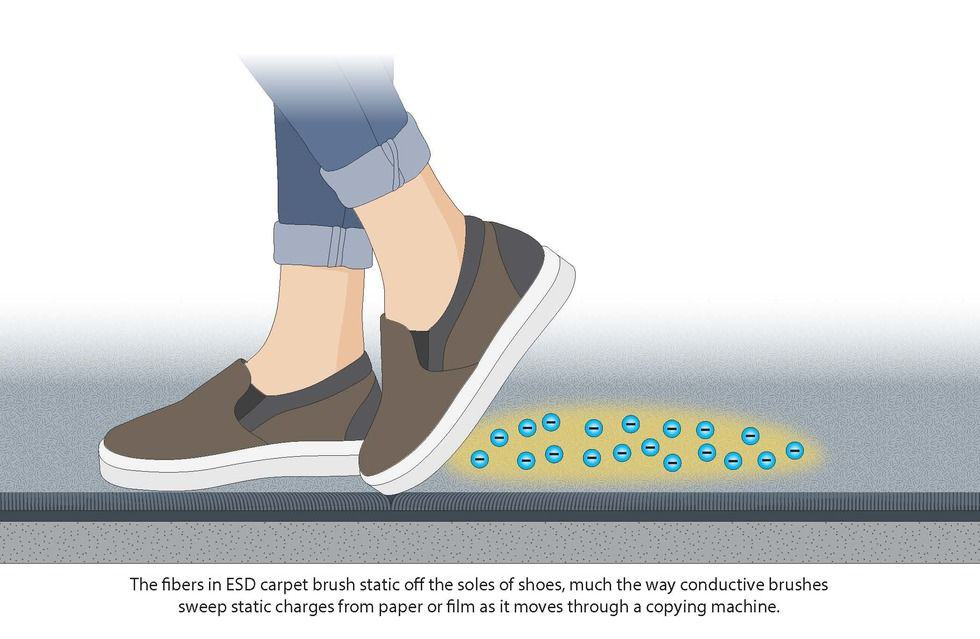

In the case of conductive carpet (a multi-layer composite construction), a conductive backing electrically connects the surface of the tiles—through the conductive fibers in the yarn bundles, via conductive precoat to the conductive fiberglass and carbon-loaded black backing, to the conductive adhesive or underlayment, to ground. Most conductive carpet tile installations measure above 25,000 ohms, typically 2.5 x 10E4 to 1.0 x 10E5. But any increase in moisture in the environment—a rise in ambient RH or changes in the concrete dew point—would increase the conductivity of the tiles, and could reduce the floor’s electrical resistance below the level of acceptibility.
In an electronics application, where mandates require the use of ESD footwear, low conductivity is typically not a problem. In an end-user space, with people wearing regular street shoes and working with energized equipment, it could pose a safety risk.
Installing highly conductive carpet over a less conductive adhesive will raise system resistance—that is, the resistance of the entire system; carpet, adhesive, and shoes worn by the test subject, standing on the carpet—masking the problem. The resistance of the carpet itself doesn’t go up.

Remember: systems readings, the resistance of the carpet simply seems higher. Potential safety risks are the same.
The PVC backing on static-dissipative carpet, on the other hand, slows the flow of current from the walking surface, through the carbon fibers in the yarn to the conductive adhesive or subfloor. With a resistance of 10E6, dissipative carpet safely and effectively transports charges to ground—with no appreciable vulnerability from environmentally-induced fluctuations.
In the case of conductive carpet (a multi-layer composite construction), a conductive backing electrically connects the surface of the tiles—through the conductive fibers in the yarn bundles, via conductive precoat to the conductive fiberglass and carbon-loaded black backing, to the conductive adhesive or underlayment, to ground. Most conductive carpet tile installations measure above 25,000 ohms, typically 2.5 x 10E4 to 1.0 x 10E5. But any increase in moisture in the environment—a rise in ambient RH or changes in the concrete dew point—would increase the conductivity of the tiles, and could reduce the floor’s electrical resistance below the level of acceptibility.
In an electronics application, where mandates require the use of ESD footwear, low conductivity is typically not a problem. In an end-user space, with people wearing regular street shoes and working with energized equipment, it could pose a safety risk.
Installing highly conductive carpet over a less conductive adhesive will raise system resistance—that is, the resistance of the entire system; carpet, adhesive, and shoes worn by the test subject, standing on the carpet—masking the problem. The resistance of the carpet itself doesn’t go up.

Remember: systems readings, the resistance of the carpet simply seems higher. Potential safety risks are the same.
The PVC backing on static-dissipative carpet, on the other hand, slows the flow of current from the walking surface, through the carbon fibers in the yarn to the conductive adhesive or subfloor. With a resistance of 10E6, dissipative carpet safely and effectively transports charges to ground—with no appreciable vulnerability from environmentally-induced fluctuations.
The Sweet Spot
Today, industry consensus is that a floor should be neither so conductive that it poses a safety risk nor so high in the dissipative range that it cannot bleed static charges as quickly as they are generated.
For safety and optimal performance, the goal is to find materials with resistance values in the mid-range, what we call “the Sweet Spot.” That is, between 1.0 x 10E5 and 1.0 x 10E8.
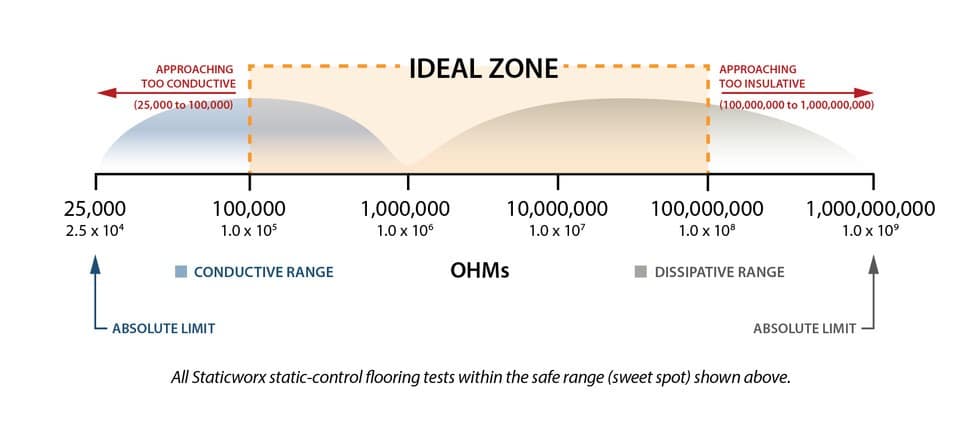

Any flooring material that measures within this range will safety and effectively discharge static to ground.
Proper Testing
To be sure the floor you choose will satisfy performance criteria, it’s crucial to do the proper testing in accordance with industry standards. To test electrical resistance, all industry standards require following the procedures outlined in ANSI/ESD STM7.1, for both point-to-point resistance (Rtt) and resistance to ground (Rtg).
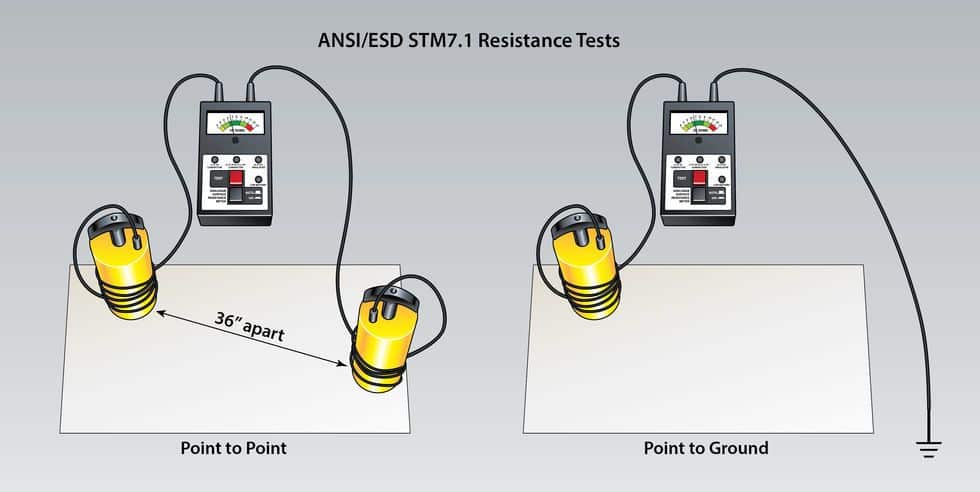

As humidity affects conductivity, the flooring material should be conditioned in a controlled chamber at 12% RH for three days prior to testing. Testing at low RH ensures that the floor does not require high ambient humidity to be adequately conductive.
A system resistance test, done in accordance with ANSI/ESD S97.1 should be performed to measure the resistance of the flooring system—i.e., the flooring material, conductive adhesive, and shoes worn by the test subject.
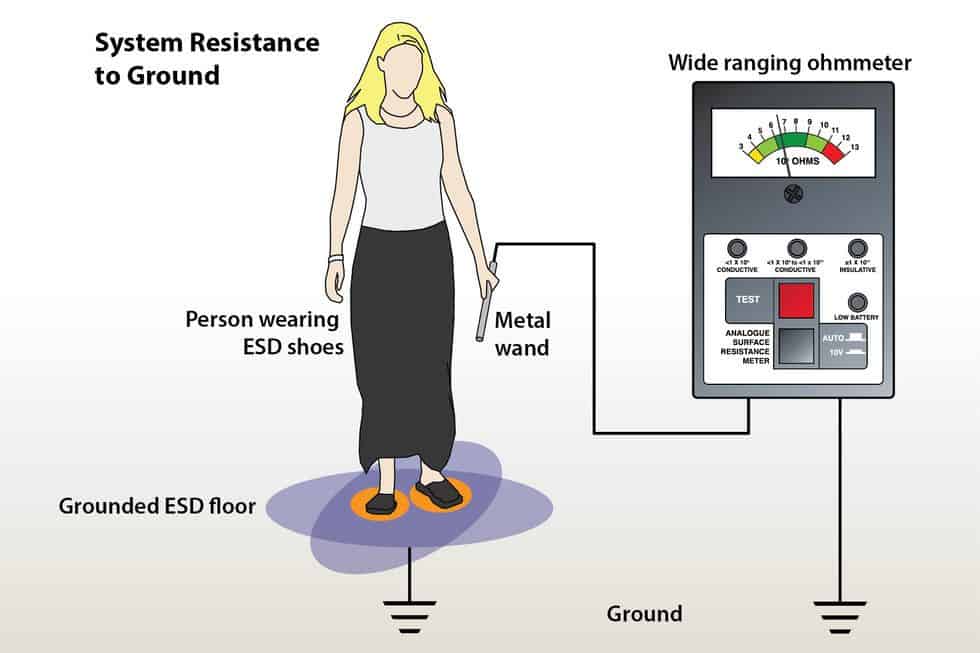

Inconsistency in readings for material and system resistance suggest that resistance values have been artificially altered by a component in the flooring system and should be investigated.
To determine whether the floor will generate static when people walk, follow ANSI/ESD STM97.2 to test walking body voltage.
System resistance and body voltage tests should always be performed with the test subject wearing footwear that’s as close as possible to the shoes people are likely to wear in the space.
To Avoid Confusions, Eliminate the Terms Conductive & Dissipative from Conversations About ESD Floors.
While conductive and dissipative may be useful for interpreting electrical standards, specifying a floor based only on resistance values is asking for trouble. Rather than deal with needless confusion—or risk specifying a floor that ultimately fails—it’s wise to eliminate the terms conductive and dissipative from conversations on the specification or selection of an ESD floor.
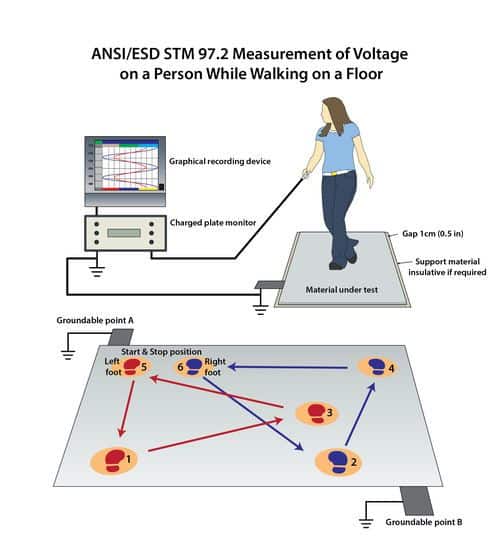
To be sure the floor you select will provide adequate static protection and prevent damage from random static discharge:
- Take the time to learn and understand industry-applicable standards like FAA 019f, ATIS 0600321-2015, Motorola R56, and ANSI/ESD S20.20;
- Take stock of the environment and application, paying particular attention to the shoes people will wear in the space;
- Be aware that some ESD floors can generate significant static charges on people wearing regular street shoes;
- Evaluate materials based on chemical and physical makeup;
- And always test the floor, following the procedures outline in STM97.2, to evaluate charge generation, and STM7.1, to be sure it meets the promised resistance criteria.


Can you identify the “Sweet Spot” for electrical resistance? In this cartoon video, we take a humorous look at electrical resistance, as described by Ohm’s Law. Animated sequences illustrate the relationship between resistance, voltage, and current, and show why the “Sweet Spot” – 1.0 x 10E5 – 1.0 x 10E10 Ω – is the optimal resistance range for ESD flooring.
Get in Touch
The form below will help us better understand your needs and get you as quickly as possible to the right person. We look forward to helping you solve your static problem!
You can expect a response within 24 hours. For faster service, please give us a call: 617-923-2000
"*" indicates required fields
Visit our privacy policy to find out how we process data.
Learning Center Articles
- ESD Basics
- Installation & Maintenance
- Selecting & Specifying an ESD Floor
- Technical Information
- 7 Common Mistakes Selecting an ESD floor
- A Guide to ESD Flooring Selection
- Avoid Costly Failures: What You Need to Know When Specifying ESD Flooring
- Choosing ESD Flooring for:
- ESD Footwear: What Is It and When Is It Necessary?
- ESD Footwear for Electronics Manufacturing and Handling Applications
- Facility Managers’ Guide to Selecting ESD Flooring
- The Need for Due Diligence in Specifying Static-Free Flooring
- Standard of Care for Specifying Floors in Mission-Critical Spaces
- Understanding the Hidden Costs of ESD Flooring

StaticWorx high-performance static-control floors protect electronic components, explosives, and high-speed computers from damage caused by static electricity. ESD flooring is part of a system. Choices should always be based on objective, researched evidence. When you partner with us, we look at all possible items that may need to integrate with the floor, and, focusing on your goals and objectives, help you find the right floor for your application.










